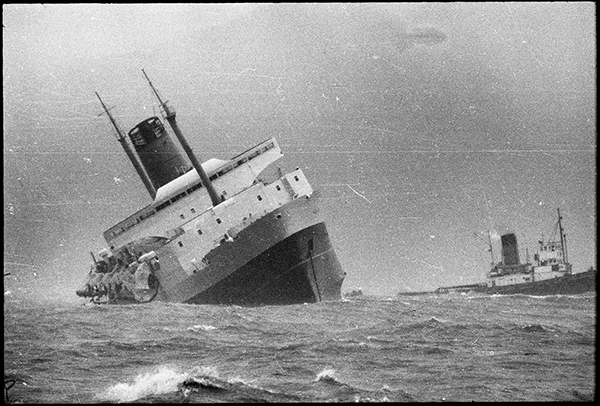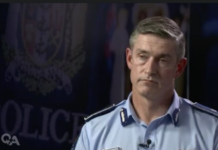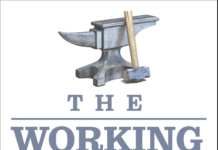
An Interislander ferry sounded its horn to mark the time the Wahine struck Barrett Reef this morning and, weather permitting, another will form the backdrop to a flotilla on Wellington Harbour this afternoon, as KiwiRail helps commemorate the 50-year anniversary of the Wahine tragedy.
KiwiRail is a key sponsor of this year’s Wahine 50th commemorations, taking place today.
“The rail ferry Aramoana, which was part of what is now the Interislander fleet, played a role in rescuing passengers from the Union Steam Ship Company’s Wahine. Crew from Aramoana bravely volunteered to man lifeboats in the rough seas and rescue passengers and crew from the sinking ferry,” says KiwiRail Chief Executive Peter Reidy.
“KiwiRail and Interislander wanted to help commemorate this event as it’s important to recognise the lives that were lost and saved, the brave rescuers involved and the impact it has had on the maritime industry.
“The Wahine disaster helped shape maritime safety systems in New Zealand, and changed the way ferries operate on the Cook Strait.
“Today, we have better designed ships, improved bridge management systems, state of the art weather forecasting, comprehensive seafarer training and stricter regulations, all of which mean sailing on the Cook Strait is a much safer experience for customers and crew than it was 50 years ago.
“The Wahine disaster also changed the way New Zealand responds to disasters and gave rise to organisations such as the Life Flight rescue helicopter service, which Interislander supports.
“We are honoured to help commemorate this important event in New Zealand’s history.”
As part of the 50th anniversary commemorations in Wellington on 10 April, the Interislander ferry Aratere sailed past during the Dawn Service at Eastbourne. It sounded its horn at 6.41am, the time the Wahine struck Barrett Reef, and a wreath was thrown from the deck of the ferry to mark the occasion.
This afternoon, the Interislander ferry Kaiarahi will sit as the backdrop to a flotilla steam-past of around 40 boats in Wellington harbour (including some which took part in the Wahine rescue 50 years ago).






Protecting our environment & health.
In association with other Community Groups, NHTCF and all Government Agencies since 2001.
Public COMMUNITY REQUEST ; letter of public safety; – Lower ‘road freight trucks’ still increasing at 6% a year. (NZTA)
Re-open notably the Napier to Gisborne rail line.
Press release – Save our NZ rail project. 2012 – 2018 from Citizens Environmental Advocacy Centre. (CEAC) Est’ 2001.
11th April 2018.
Minister for Economic Development Shane Jones say’s he is getting mixed messages about support for Gisborne rail, this article should clear up the minister’s misunderstanding.
gisborneherald.co.nz
Do port, ECT care about impacts?
by Ken Crispin
Published: April 4, 2018 12:09PM
COLUMN
Last Thursday we attended a Gisborne District Council “pre-hearing” meeting for Eastland Port’s log berth expansion plans.
A few community members’ continuing submissions were heard at this pre-hearing at the Waikanae Surf Life Saving Club, before “secret” Chatham House Rules applied.
Our submitter was ignored during earlier submissions, saying the planned expansion should be made under the usual “regional plan change”, rather than a Resource Management Act application.
The aim is to have the process made transparent, and allow the community to have their right to make changes to the way the port operates in future, in a more environmentally responsible manner.
Transportation of logs to the port almost 24 hours a day is a major concern, with the bulk of submitters voicing opposition to the industrial noise generated. Many were losing sleep.
Past submissions to GDC on logging truck noise may have been overlooked.
We made a strong case after receiving a petition in 2011-12 from the Esplanade community group, signed by 280 people, asking GDC to mitigate against the excessive noise, vibration and air pollution of port-bound logging trucks.
The pre-hearing chairman, GDC’s consents manager, may wish to consider our submitter’s push for a regional plan change scenario rather than the restrictive, secretive process Eastland Community Trust-owned Eastland Port appears to prefer.
Does Eastland Port care about wider community impacts of negative noise, vibration and air pollution from its “industrial activities in a built environment”? If not, can GDC encourage ECT and its company to be environmentally and socially responsible?
As former residents of Napier before settling in Gisborne in 2005, our community there suffered similar problems to what Eastland Port is causing. Fourteen suburban communities surrounding Port of Napier have truck noise, vibrations and air pollution from export freight being carried to the port.
Our groups there have met with Napier Port executives at their boardroom, receiving a strong level of support from the port company over these issues.
So we are surprised ECT and Eastland Port are not reciprocating with suburban communities surrounding their port. Are they worried about criticism from the wider community of Gisborne?
Since 2002 my wife and I have operated an environmental monitoring company, CER Ltd, that has partnered with government agencies as well as Watercare and Niwa. Our company has reviewed Eastland Port’s “independent environmental assessment” report and we have several concerns.
Many communities around New Zealand suffer from truck traffic to ports. A new method of measuring “industrial noise” is warranted, as used by the World Health Organisation and the European Union. The monitoring of residential urban noise, vibration and air pollution from truck freight is a long debate now which we will take up again with GDC/ECT.
We support the request made by Winston Morton to change the port’s application to a more inclusive, far less secretive procedure.
The port, with its narrow focus “only inside the port noise zone”, is restricting residents from seeking mitigation to the negative truck effects of noise, vibration and air pollution.
Our other submitter at the GDC pre-hearing was Rail Action Group chairwoman Gillian Ward, who expressed the wish that Eastland Port consider rail to move logs to its wharves.
We support rail freight to ports around New Zealand, which was the plan in the Labour government policy from 2004 called NZ National Rail Strategy to 2015.
The new Labour-led Government has committed to the transition to a low-carbon or a net-zero carbon economy.
So the Government needs to get our rail line reopened, and to plan to electrify the rail service.
Save lives with rail freight lowering ‘truck gridlock.’
The anniversary came and went with various stories of sadness and heroism.
Not once did I hear or read of the cause of the sinking.
The captain did not want to bring the Wahine into the heads but wished to ride out the storm in the Straits, an action he had every confidence would be successful.
He was directed from head office to bring the Wahine into berth to maintain the schedule. His objections to that were over ridden in spite of the captains judgments presented.
Business comes before people. Those who made the order need to be held to account and popular history more honestly portrayed.
The tragedy simply did not need to happen.
Comments are closed.